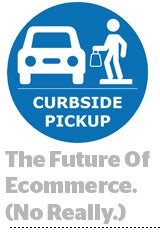 Walmart and Target, which both reported quarterly earnings this week, underscore how American shopping habits are being reshaped.
Walmart and Target, which both reported quarterly earnings this week, underscore how American shopping habits are being reshaped.
Walmart and Target both saw a double-digit increase in average cart value (16.5% and 12.5%, respectively) and a single-digit decline in the number of transactions, since people stocked up with fewer shopping trips. Older Americans also boosted ecommerce with buy online pick up in store (BOPIS) orders, because they have higher exposure risks and stopped entering stores.
Those changes are unsurprising responses to the coronavirus crisis. And while it’s uncertain how shopping patterns will continue to evolve, or if they’ll revert after the pandemic is over, this moment is an important reset for American consumerism.
Target has always tried to identify pivotal life moments that reshape shopping habits, such as going to college, getting a new home or adding a new baby to a household, said CEO Brian Cornell during the earnings call.
“Right now, across America, we’re seeing this change in shopping habits,” he said.
The profit problem
The most stunning growth for Walmart and Target has been in ecommerce, with Walmart’s online sales increasing 74% YoY, and Target’s digital sales up 282% YoY in April.
But ecommerce isn’t and hasn’t traditionally been really profitable.
Even Amazon doesn’t wring immense profits from its online store: It does that through advertising and, mostly, the Amazon Web Services cloud business.
For big retail chains, ecommerce is an investment, not necessarily a profit driver. The focus has always been getting people to stores, where shoppers add more items to their carts and the retailer doesn’t pay for online traffic acquisition, shipping and returns.
And ecommerce eroded Walmart’s and Target’s Q1 profit margins. Both companies cited changes in “sales mix shifts” for part of those margin declines. What they mean is that ecommerce and grocery sales are not as profitable as people coming to a store and buying clothes, groceries and whatever else comes to mind.Ecommerce is also expensive. Walmart hired 235,000 employees since mid-March, and fulfillment centers quadrupled head count from January. Target is expanding its parking lot capacities to accommodate pick-up orders, reshaping stores so groceries and freezers are easily accessible for pick-ups (grocery orders can’t be sitting around at room temperature) and hiring and training associates for pick-up orders and requests. (“You’re out of chicken and gave me turkey but I want pork instead.”)
Long-term gains
Don’t get the wrong impression, though. Walmart and Target are more committed and optimistic about ecommerce investments now than even a few months ago.
“There is a real risk in over-rotating from profit rate headwinds [in ecommerce],” said Target COO John Mulligan, when an investor noted ecommerce drove to down gross profit margins.
“The economics of digital transactions are so much bigger than a single transaction,” he said.
For instance, Target’s drive-up service (aka BOPIS) has a higher net promoter score than any other form of fulfillment, Cornell said. Another high-NPS product is Shipt, the same-day delivery service Target bought two years ago.
Those high marks from customers are the best indicators of likely return shoppers, he said.
Walmart is also starting to see the ecommerce flywheel start to move, which will create a profitable, more sustainable model, said Marc Lore, CEO of Walmart’s ecommerce business.
Walmart is taking a marketplace approach, where its ecommerce properties sell more items than are stocked on shelves in stores, and outside sellers or brands can manage their own sales on the platform. This strategy resembles how Amazon has both its own retail business and hosts third-party sellers.
Lore said Walmart’s online marketplace is accelerating faster than Walmart’s first-party retail business, selling goods it wholesales itself.
Those new sellers are adding products beyond food and grocery, so the mix of ecommerce sales overall will be more profitable.
“I think it’s time we stop referring to our supercenter pickup and delivery capability as online grocery, because it’s becoming much more than grocery,” Walmart CEO Doug McMillon told investors.
And as Walmart gains traction, its ecommerce cost structure comes down. The Walmart app surpassed the Amazon app as a popular download on the Apple App Store for the first time ever this month. The Walmart App was the 13th most popular app in the United States on May 19, two spots ahead of Amazon and just behind Snapchat, according to App Annie.
Part of what’s expensive about ecommerce is that the retailer has to pay for downloads, affiliate links, traffic acquisition and for promotions and discounts so people will purchase.
If Walmart’s app is sticky enough, it gets the benefits of ecommerce shopping without the performance marketing and other expenses.













